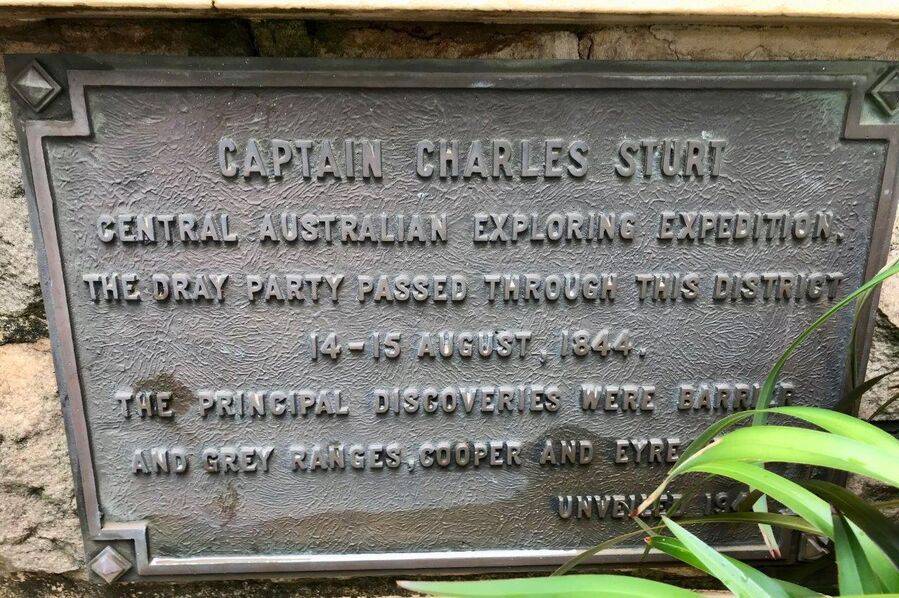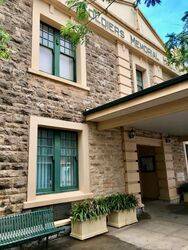
Home » Themes » Landscape » Exploration
Captain Charles Sturt & Central Australian Exploring ExpeditionPrint Page 
The plaque commemorates Captain Charles Sturt and the Central Australian Exploring Expedition of 1844 and 1845. The plaque was unveiled during the centenary of the expedition in 1944.
Sturt was driven by a conviction that it was his destiny to discover a great salt water lake, known as 'the inland sea', in the middle of Australia. At very least, he wanted to be the first explorer to plant his foot in 'the centre' of Australia. In August 1844, he set out with a party of 15 men, 200 sheep, six drays and a boat to explore north-western New South Wales and to advance into central Australia. They travelled along the Murray River and Darling River before passing the future site of Broken Hill, but were then stranded for months by the extreme summer conditions near the present site of Milparinka.
When the rains eventually came Sturt moved north and established a depot at Fort Grey in today's Sturt National Park. With a small group of men, including explorer John McDouall Stuart as his draughtsman, Sturt pressed on across Sturt`s Stony Desert and into the Simpson Desert, at which point he was unable to go further and turned back to the depot. Sturt made a second attempt to reach the centre of Australia, but he developed scurvy in the extreme conditions. His health broke down and he was forced to abandon the attempt. John Harris Browne, surgeon on the expedition, assisted Sturt, took over leadership of the party and after travelling 4800 kilometres brought it back to safety.
River centres participated this week in celebrating the Centenary of Capt. Charles Start's epic expedition in search of the centre of Australia. At Morgan and Renmark, fresh plaques were unveiled on the existing "Sturt Cairns" which were erected 14 years ago to commemorate the famous explorer's great journey of discovery down the River Murray 100 years earlier. At Barmera, a new memorial was unveiled in Barwell Avenue. The ceremonies were attended by representatives of the Historical Memorials Committee of the Royal Geographical Society, at whose instigation they had been arranged. In the present series of ceremonies, other towns to participate were Nuriootpa, Angaston, Light's Pass, and Truro all of which are definitely marked localities in Sturt's record of his journey. Earlier ceremonies were held at Gawler and Adelaide. Broken Hill also has taken an especial interest in the celebrations, as it was on the expedition in question that Sturt discovered the Barrier Range.
Excerpt from Murray Pioneer (Renmark, SA), 21 September 1944.
Location
| Address: | Murray Street, Soldiers Memorial Hall, Nuriootpa, 5355 |
|---|---|
| State: | SA |
| Area: | AUS |
| GPS Coordinates: | Lat: -34.470719 Long: 138.99685 Note: GPS Coordinates are approximate. |
Details
| Monument Type: | Plaque |
|---|---|
| Monument Theme: | Landscape |
| Sub-Theme: | Exploration |
| Actual Event Start Date: | 14-August-1844 |
| Actual Event End Date: | 15-August-1844 |
| Link: | http://adb.anu.edu.au/ |
Dedication
| Approx. Monument Dedication Date: | 1944 |
|---|
Captain Charles Sturt
Central Australian Exploring Expedition
The dray party passed through this District
14 - 15 August, 1844.
The principal discoveries were Barrier and Grey Ranges, Cooper and Eyre Creeks
Unveiled 1944






